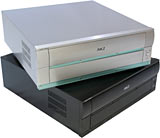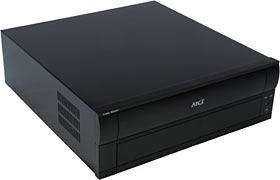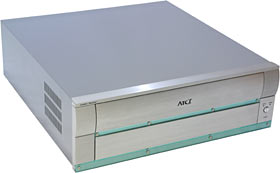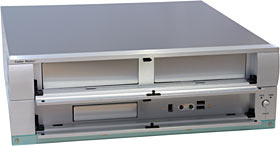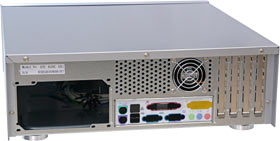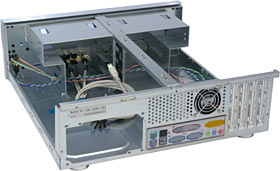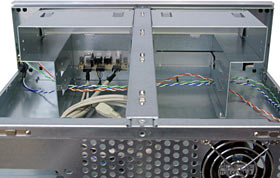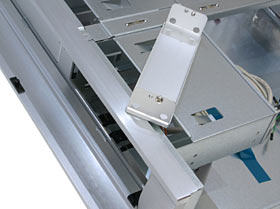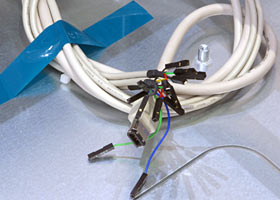
Cooler Master ATC-620-SX1 and BX1 cases
Review date: 13 May 2003.Last modified 03-Dec-2011.
Are you tired of PCs that look like PCs?
You know what I mean. Maybe it's black, maybe it's silver, but it's probably beige. Probably a mini-tower case, maybe a desktop, styled either to induce coma in anyone who looks at it or to impress people with unusual ideas about beauty.
Oh, you can spice a boring PC up with windows and lights and what have you, but that's not going to turn a duck into a swan.
So here's an option.
Cooler Master's ATC-620 cases accept standard microATX motherboards (or FlexATX boards, if you don't need much in the way of expansion slots), they've got two 5.25 inch drive bays and three 3.5 inch bays, and they use a standard ATX power supply.
By "premium" PC case standards, these ones are pretty cheap. Here in Australia, Aus PC Market stocked each of them for $AU261.80, including Sydney metropolitan delivery (but they don't any more, as of late 2004). That didn't include a power supply, but that's normal for fancy-looking cases.
As I write this, Aus PC are selling Lian Li's somewhat similar PC-9300 (review here) for only $AU241 delivered (again, not including PSU). But the ATC-620s have some advantages over the PC-9300.
Those advantages do not include weight. At a glance, the black ATC-620-BX1 and silver ATC-620-SX1 look like aluminium cases. Partly, they are; their hi-fi-component-ish front panels are cast aluminium with a brushed finish, and look quite good enough to join the stack-o-technology in any geek's living room. The rest of the panels in these cases are plain old steel, though.
Which, if you ask me, is fine. Aluminium cases are lighter than steel (the ATC-620s weigh six and a half kilos), but the difference seldom adds up to much once you've built an actual PC inside the case. Aluminium also won't rust, but a PC has to be installed pretty close to the seaside before that matters to most users. And aluminium's a better thermal conductor than steel, but it's throughflow ventilation that provides the bulk of the cooling for a PC. The conductivity of the panel metal makes little difference.
The ATC-620s are 423mm wide by 140mm high by 445mm deep (16.7 by 5.5 by 17.5 inches). This lets them blend in nicely with stereo equipment, since they're the same width as a normal full-sized amplifier or receiver, and not a great deal deeper.
These aren't just niche Home Theatre PC (HTPC) cases, though. They'd look fine on a desk, too.
Black, black, black. The ATC-620-BX1 is a black case. And a sharp looking one, too. No garish silver buttons. Doors to hide your removable media drives. Which can, therefore, be as beige as you like without spoiling your PC's pose value.
The ATC-620-SX1 isn't all silver; it's got a couple of aquamarine acrylic inserts where the BX1 has more black metal. It's otherwise identical to the BX1, and it's easier to photograph, so you'll be seeing it from here on.
The two doors are made from hefty solid aluminium, but their high-class appearance is slightly spoiled, in the SX1's case, by the black hardware visible around them - particularly the black gears at the ends of the hinges. The BX1 doesn't have this problem, of course.
The gears are there for the doors' soft-open mechanism; it's a simple greased-gear arrangement where the gear on the left hand side of the hinge drives another gear, which runs on a heavily greased high-drag axle. You'd think that such a system would dry out and then let the doors clatter open, but greased-gear arrangements actually last remarkably well. And if they do fail, at least you can still open the door.
The top door covers the two 5.25 inch bays; the bottom one hides the single externally accessible 3.5 inch bay, and a few front ports. There are two USB ports, two 1/8th inch stereo audio sockets, and one FireWire socket on the front panel.
The front doors use ordinary push-to-close, push-to-open latches, which is all very well unless you've got a drive trying to eject behind them. They won't just pop open, in that situation; the drive'll push its tray on the back of the closed door for a moment, then retract again.
If something does manage to pop open this kind of latch, it won't break it. But I doubt even two tray-load drives pushing at once could do it. Slot-load drives definitely wouldn't have a chance.
Unexpected drive ejection [note: this Funny Link only does something entertaining if you click it in Internet Explorer] isn't normally much of a problem, of course. If you're writing CDs or DVDs then you'll probably have some auto-ejects to deal with, but then you'll have to have opened the door on the case in the first place, to put the blank disc in.
Note that the ATC-620 doors aren't lockable, and the push-to-open latch is probably the least childproof one ever made. If your home or office contains humans or other entities of an age to engage in gefengerpoken und mittengrabben, or merely the insertion of cheese slices in CD-ROM drives, then you might prefer a case with a lockable door instead.
The back panel of the ATC-620-SX1. There are four standard-height expansion slots; four slots is all you get on microATX boards. There's one standard-size motherboard connector block cutout with a default ATX port-hole template installed in it; motherboards with differently arranged connector blocks come with snap-in templates to match. There's a hole for an ATX PSU. And there's a ventilation panel with a pre-installed 60mm diameter, 25mm thick exhaust fan.
This isn't much of an exhaust fan, but that isn't a big deal, because of the normal ATX power supply. All but the strangest of ATX supplies have at least one 80mm exhaust fan, and even the "silent" models ought to shift enough air through an ATC-620 to keep most PCs more than cool enough.
The ATC-620 with its lid off. There's nothing very luxurious in here, but it gets the job done. The drive bays aren't removable, but they're easy enough to access; there are a few sharp-ish edges, but you ought not to lose much blood.
Note the things sticking up out of the central strut; they're spring-loaded balls that're there to stop the case from vibrating. This is a particularly nice feature for a living room PC. The central strut also makes these cases quite strong enough to support a good-sized monitor.
You can only screw in one side of each drive you install in an ATC-620; the non-removable bays butt up against each other in the middle and stop you from getting at that side's mounting holes. This is unusual, but not dangerous; there are springy tabs on the inaccessible side of the bays to stop the drives from rattling. Any handling that's rough enough to damage a drive that's only screwed in on one side will probably also be rough enough to totally wreck the case.
There's actually enough physical room in this case for four 3.5 inch drives, but only three of the drive bays can be used, because the front-ports circuit board intrudes a bit into the fourth one. You could still, probably, shoehorn a hard drive in there, provided it didn't foul anything on your motherboard and you were happy with retaining it with one screw, or maybe something else.
The aluminium front bay covers are also retained by a screw on only one side. They have two other screws, but they're just screwed through the sides of the bay cover itself; the rounded screw heads pop into recesses in the drive bays to retain the covers.
This isn't as neat a retention mechanism as the little stamped nubbins that current Lian Li bay covers have, but it works well enough.
The ATC-620 front panel I/O port cables terminate in one big plug - for the FireWire port - and a bunch of little tiny ones. The tiny ones will let you connect the front USB and audio ports to any motherboard that provides pin headers for those things, but only if you know the motherboard's pinout. The mobo manual ought to tell you, and the ATC-620s come with a pinout sheet to help, so the connection job shouldn't be too mystifying.
The back with the pinout sheet in it also contains a bunch of the usual mounting screws, but no fibre washers or stick-on rubber things. Never mind. Washers aren't necessary and frequently just confuse newbies, and rubber support cones aren't needed for small mobos.
You don't get motherboard standoffs in the parts bag, either, but that's because they've already been installed for you.
The ATC-620 package also includes a rear slot cover with a notch out of it, in case you need to loop the front-port FireWire cable out of the back of the PC.
Overall
If you want a case that can accept a full-sized ATX motherboard, then there aren't a lot of options besides regular mini- and midi-tower units. They're about as small as a case can be and still accept a 12 by 9.6 inch circuit board, plus PSU and drives and such.
Now that there are plenty of motherboards on the market with acceptable video, sound and network adapters all built in, though, many people don't need a full ATX board. All ATX boards have that smaller boards don't is extra expansion slots.
Quality integrated mobo chipsets have resulted in the popularity of Small Form Factor (SFF) systems (like this one). The fact that SFF boxes take up a really tiny amount of room isn't terribly important to many people. though ultra-portable LAN party boxes and cheap work PCs that you can easily take home on the train have their attractions. It's the aesthetics of a proper PC the size of a toaster, probably with quite snappy styling, that sells a lot of SFF machines. They don't generally look too good in your stereo cabinet, though.
The ATC-620s' obvious target market is the living-room-PC crowd, but these cases aren't so specialised as to be useless for other purposes. If you want a desktop PC with presence, these cases will do it for you.
They're not just for home users, either. These cases look as if they could contain some ludicrously expensive custom workstation, or at the very least a quad Opteron system. So businesses looking for snazzy computers on the cheap may be interested, too. Everyone in the company doesn't need one of these, but they'd look good on the reception desk or in the conference room.
The are tons of microATX motherboards available today, so you could spec up an ATC-620-based system for anything from light word processing to serious 3D gaming. Even the higher-spec microATX boards are quite pleasingly cheap, too; there's no small-production-run price premium, which you'll pay if you try to build a really tiny PC.
Whatever hardware you install in these cases - within their drive bay and motherboard-size limits - you shouldn't have any trouble powering it. Many hi-fi-ish cases - including the Lian Li PC-9300 - use weird SFX power supplies, which top out at less than 200 watts, and can be hard to find. The ATC-620s take the same ATX PSUs as every other sensible case.
If you don't care what your PC case looks like, the ATC-620s are overpriced. If you do care, though, then they're really quite cheap, for what you get. I like them.
Buy
one!
Aus PC Market don't sell these
products any more (click
here to see their current case-related products), but you can still try a
price search at
DealTime!
